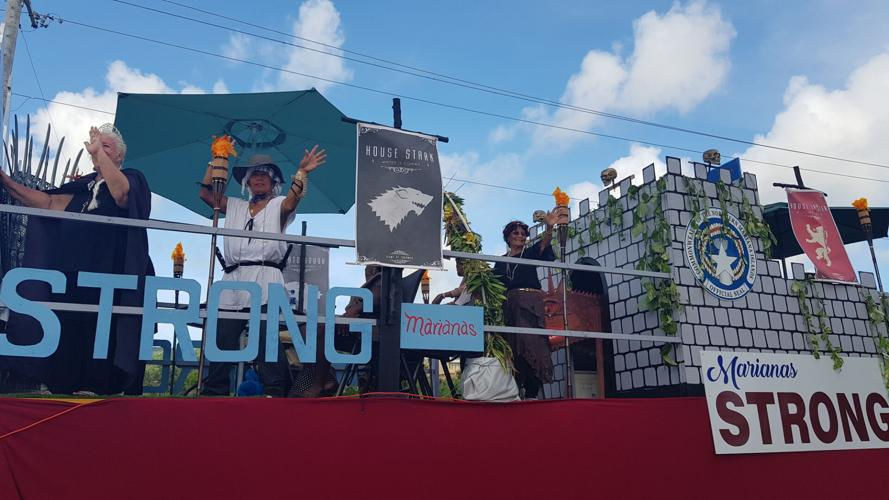Saipan’s first Liberation Day
- Admin

- Jul 4, 2023
- 4 min read


Saipan — The Fourth of July is celebrated in the Northern Mariana Islands as Liberation Day, marking “the permanent closure on July 4, 1946, of civilian internment camps in Saipan, when indigenous Chamorros and Carolinians were allowed to fully return to their land and lives following World War II.”
Unlike Guam, the NMI was under the Flag of the Rising Sun before the war, and was seized by the U.S. in the summer of 1944 so it could bomb the bejesus out of Japan.
In his fascinating 1954 book, “Saipan: The Ethnology of a War-Devastated Island,” American anthropologist Alexander Spoehr called the island “unfortunate.” Saipan and the rest of the Marianas “lay directly in the path of war,” and “were as vital to Japanese defenses as to the American offensive across the Pacific.”
During the American invasion of Saipan, Spoehr said the Chamorros and Carolinians tried to seek cover in caves, “and often by shifting their hiding places.” For locals, he added, “the invasion was a harrowing experience. Apart from the danger, they soon ran out of food and water, and their clothing was shredded to rags; they were in wretched condition when they finally reached the safety of internment camps. Many were wounded; over 300 were killed.” That’s about 10 percent of the local population on Saipan at the time.
“The Chamorros and Carolinians lost all their material possessions,” Spoehr said. “The larger society in which they existed as a small part was destroyed. The economy of Saipan was utterly devastated.”
The war traumatized the local people. “In 1950,” Spoehr noted, “with the outbreak of the Korean War, the community became extremely jittery. Stocks of rice in the stores were bought up as families attempted to lay in food; rumors of every sort ran through the island. The people did not calm down until it became apparent that Saipan was not under attack.”
After the U.S. invasion, Spoehr said the island was transformed into a huge American military base. When “the tides of war receded from Saipan’s shores…military activity was cut back.” In 1950, the last military installation was closed.
“During this period,” Spoehr said, “the Saipan people experienced a variety of vicissitudes. After the capture of the island, they were kept in a camp separate from those containing Japanese and Korean civilians….” (Korea was under Japanese rule from 1910 to 1945. Thousands of Koreans were drafted into the Japanese military.)
In November 1944, Spoehr said, the Chamorros and Carolinians were moved into Chalan Kanoa, “where some new housing units were constructed to relieve the congestion. They were, however, kept behind barbed wire until after the repatriation of the nearly 14,000 Japanese and over 1,300 Korean civilians in the spring of 1946. After this, [the locals] were granted freedom of movement.”
ADVERTISEMENT

Liberation Day had arrived.
Under U.S. military (Navy) rule, “[h]ouses and stores were built; abandoned jeeps were reconditioned; Chamorro boys began to wear aloha shirts and the girls learned to use lipstick and read American fashion magazines. A school was opened…. The church was…re-established. Political elections for community leaders were held, and in 1947 the municipality was instituted.”
According to Spoehr, locals “were in demand for government employment,” and “a local economy soon developed that depended on government employment. The extent of farming…was minimal.”
This economy, Spoehr added, was “extremely vulnerable and started to collapse as soon as [U.S.] military installations began to close down.”
By the summer of 1950, he said, only the U.S. Navy’s administration unit remained as a source of employment. In a report, an economic survey board stated that Saipan “is…in the worst economic straits of the inhabited islands of the northern Marianas chain. Saipan’s economy since the war has been established on a false, untenable basis, almost complete reliance on wages paid by the [U.S.] military [government] for types of work that contribute nothing to the real wealth of the island.”
Saipan’s executive branch was headed by a paid, full-time mayor elected by popular vote for a four-year term. The executive departments under the mayor were the treasury, economics, public works, education, public health and public safety.
The legislative branch consisted of 14 commissioners and 11 councilmen. (Saipan’s population in 1950 was less than 5,000. The island’s estimated population today is over 40,000. Number of Saipan lawmakers: 18 House members and three senators.)
The commissioners and councilmen formed the Congress of Saipan. “At first these two groups met separately,” Spoehr said, “but in order to simplify procedures and achieve a more workable organization they decided to meet together, which they do about once a month.” The legislative body’s deliberations, however, “have been marked by endless discussion and bickering and general ineffectiveness….”
The municipality, Spoehr added, operated on a sizeable budget. “At the close of the fiscal year 1949-50, the mayor presented a budget of $65,000 [equivalent today to over $690,000] to the legislative branch, covering expenditures for the following year. In the budget, expenditures exceeded the most generous expectations of revenue by over $7,000 [worth over $74,000 today].
The commissioners and councilmen cut the budget by several thousand dollars and passed it on to the [U.S.] administration which pointed out that even with the proposed cuts there was little hope in the present precarious state of the island economy that revenues would be adequate for the proposed expenditures. Thereafter, the matter was dropped, and nothing was done, except that the mayor did not accept the cuts recommended by the legislative branch. He further authorized the purchase of a new second-hand jeep for the municipality, much to the disgust of some citizens.”
Big government. Lousy economy. Disenchanted citizens.
Over 70 years ago — and today.
Zaldy Dandan is editor of the NMI’s oldest newspaper, Marianas Variety. His fourth book, “If He Isn’t Insane Then He Should Be: Stories & Poems from Saipan,” is available on amazon.com/.
Subscribe to
our digital
monthly edition






